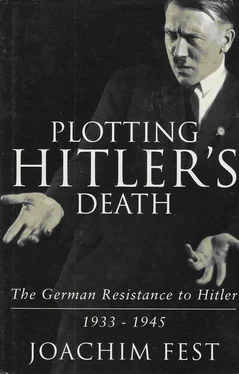Hans Oster had decided after much mental anguish that all resistance of the kind practiced hitherto was doomed to failure. Not only was the conspirators’ ability to act severely limited by traditional notions of gentlemanly behavior, but worse yet, they could not get around the objection that a coup would have little chance for success so long as Hitler suffered no political or military defeat severe enough to break his spell over the German people, at least momentarily. It seemed to Oster that such a defeat should therefore be arranged.
This was a perilous conclusion. But in his despair and helpless rage Oster realized much more clearly than most of his colleagues that National Socialism represented an entirely new phenomenon: an ideology of such sinister immorality that traditional values and loyalties no longer applied. For this reason, Oster commissioned Dohnanyi to gather information about the crimes of the regime both in Germany and, starting in September 1939, in Poland. Oster was hardly surprised when the misgivings he expressed about an offensive in the West through Dutch and Belgian territory were brushed aside by Hitler. With all these examples in mind, Oster forced himself to overcome his final inhibitions and take the step that led him to treason.
In the early 1930s he had made the acquaintance of a young Dutch officer named Gijsbertus Jacobus Sas. At the time of the 1936 Olympic Games, they became fast friends. When Sas, having risen to rank of colonel, was appointed a military attaché to the Dutch embassy in Berlin, they renewed their friendship and grew increasingly close despite the enthusiastic admiration of Sas’s wife for the German Führer. On the evening of October 8, 1939, Oster was on his way home to 9 Bayerische Strasse with his occasional driver, Franz Liedig. Silent and sunk in thought, Oster suddenly asked to be dropped off at Sas’s apartment. When he returned a few minutes later and took his place beside Liedig, Oster blurted out that now there was no going back: he had just committed high treason and, if discovered, would be hanged. In an extremely emotional state, he revealed all that had driven him to this point, concluding with words that Liedig would never forget: “It is far easier to take a pistol and kill someone, it is far easier to charge into a hail of machine-gun fire when you believe in the cause, than it is to do what I have done. If things should ever come to this pass, then please be the friend even after my death who knows how it was and what moved me to do things that others might never understand or undertake themselves.” 3
Oster’s “treachery” has fired a passionate debate in Germany, with one side claiming that under a criminal regime all notions of illegality are overturned while the other takes a more formalistic view, saying that deliberate, premeditated treason should always be a capital offense. A third group makes the point that Oster’s deed was “basically of little import” because the Belgians, to whom Sas immediately forwarded the information provided by his friend, lent it no more credence than the Dutch had. 4Furthermore, the Western powers reportedly already knew of Hitler’s intentions through many other channels. But these and other attempts to diminish, excuse, or condemn Oster’s decision fail to come to grips with its seriousness and true intent; they also overlook the fact that Oster had crossed a crucial dividing line: he was prepared to cause the death of German soldiers if necessary, a position that practically none of the other members of the resistance could accept, no matter how much they still respected him.
It is impossible to assess Oster’s actions properly without considering that his intent was not to injure Germany but to spare it the catastrophe that would inevitably result, in the unanimous view of the generals, if the original plans were followed and Western Europe was invaded immediately after the Polish campaign. His motive was to do everything he could to prevent the impending catastrophe that Hitler, after successful invasions of Czechoslovakia and Poland, was determined to visit on the entire western half of Europe, Germany included. Just how close the military itself was to desperate action can he seen in the example of Walter von Reichenau, who, though he has frequently been decried as a “Nazi general,” vehemently opposed Hitler’s plans for another offensive at the conference of August 30. He then went so far as to meet with Goerdeler in the house of the former vice-mayor of Berlin, Fritz Elsas, on November 6 and encourage him in scarcely veiled terms to leak the date of the offensive to the British and Dutch so that they would begin their preparations, thus foiling Hitler’s strategic plan. 5
While Reichenau was motivated primarily by pragmatic concerns, Oster’s intentions were much more far-ranging. He hoped, for example, to reveal, or rather highlight, a paradox that was often ignored: most officers-even those who were highly critical of the Nazis-tended to focus narrowly on their own military victories and thus found it difficult to accept that their successes redounded to Hitler’s glory, augmenting his authority and power and, for the time being, his reputation for almost magical invincibility.
Oster clearly saw no way out of this dilemma without breaking free of traditional values and thought patterns. He was enough of an officer to understand how seriously his peers took their responsibility for the well-being of their troops. But the question was how that responsibility compared to the one they would bear for the millions of lives that would be lost in a world war unleashed by Hitler and whether it was even possible to address the real issues from the standpoint of individual nations and their legal systems, which protected each nation’s self-interests and made “high treason” a heinous crime. Traditional values provided inadequate tools for understanding or combating Hitler’s rule. Moreover, they failed to address the moral grounds on which, more than anything else, Oster’s fierce opposition was predicated. Some doubt may still remain, but when all the philosophical arguments have been exhausted, one point stands beyond challenge in Osier’s thinking. He himself alluded to it when he told Franz Liedig that he had made a decision on moral grounds, for which he alone was responsible and for which, if things turned out badly, he alone would pay.
Like all previous designs of the German resistance, Oster’s action failed, even doubly so. Hitler did not suffer the expected setback, since the date of the western offensive was postponed twenty-nine times in total between the autumn of 1939 and May 1940, when Wehrmacht units that had recovered their strength and were well prepared and better equipped finally smashed across the borders. Furthermore, the never-ending series of new starting dates for the attack that Oster relayed to the West made his warnings seem unreliable. The Dutch high command never placed much stock in them in any case, as the original November date struck them as too foolish and irrational to be believed, even of Hitler. They soon wrote Sas off, suspecting that he was either being deliberately misled by his secretive informer or that he had become hysterical and hoped to appear more important than he really was. As a result, all his messages were simply filed away. When Oster warned the Norwegian ambassador in Berlin of Hitler’s decision to seize Norway and Denmark the ambassador, concluding that it was a deliberate attempt to mislead him, did not even forward the information to Oslo. By the time Norway eventually mobilized, it was too late. Similarly, the British fleet, which set sail on April 7 to beat the Germans to the punch in Norway (Hitler invaded on April 9) had no idea it was in a race against time. As if to remind Oster that he had risked his life, honor, and reputation in vain, the Dutch commander in chief, General Winkelmann, told Sas that the German officer who was feeding him information must be “a pitiful fellow.” 6
Читать дальше




![Traudl Junge - Hitler's Last Secretary - A Firsthand Account of Life with Hitler [aka Until the Final Hour]](/books/416681/traudl-junge-hitler-s-last-secretary-a-firsthand-thumb.webp)







